Did you know that while fruits share the common feature of having seeds, they do not all come from the same types of plants? While it might appear as if fruits only grow on trees, many fruits grow on other types of plants, including vines and bushes.
In this article, we focus on fruits that grow on trees. We talk about different types of fruits trees, their varieties, hardiness zone, maturity period, and more. If you’re wondering what fruit tree might be best for your backyard, you’re in the right place.
Table of Contents
Apple Tree

Apple trees grow worldwide, and they are perhaps the most planted species in the Malus genus. You can grow them with seeds, cuttings, or from a seedling plant.
Apple seeds are genetically distinct from their parent trees. So, if you choose to plant your apple tree with seeds from a fruit, you may not end up with the same apple variety. Besides genetic variation, it could take around 8 to 10 years for an apple seed to mature to the point of producing fruits.
Apple trees thrive best in full sun. They prefer neutral soil pH and grow in hardiness zones 3 to 8. Apple trees produce pink or white flowers, and on average, it takes them 4 to 8 years to mature.
There are over 7500 varieties of apple trees all over the world. Some of the most popular ones are Fuji, Gala, Granny Smith, Honeycrisp, and Red Delicious.
Apricot Tree

Apricot trees are beautiful, self-fruiting trees that produce pinkish-white flowers. They bear orange stone fruits with simultaneously sweet and tart flesh.
You may plant apricot trees from seeds (pit) or a seedling plant. But if you grow from seeds, the tree may not bear any fruit.
If your apricot tree is going to bear fruits, it will do this within 2 to 5 years after planting. Afterward, it may keep producing fruits for around 20 to 25 years before it stops; apricot trees do not produce fruits for life.
Apricot trees grow best in full sun. They prefer climates with cold winters and warm – not hot – summers. Apricot trees thrive in neutral to slightly alkaline soils, and they are hardy in zones 5 to 9.
While there are several apricot varieties, Ansu Apricot is the most common one. But apart from it, some other apricot varieties include Tilton, Poppicot, Patterson, Autumn Glo, and Royal Rosa.
Avocado Tree
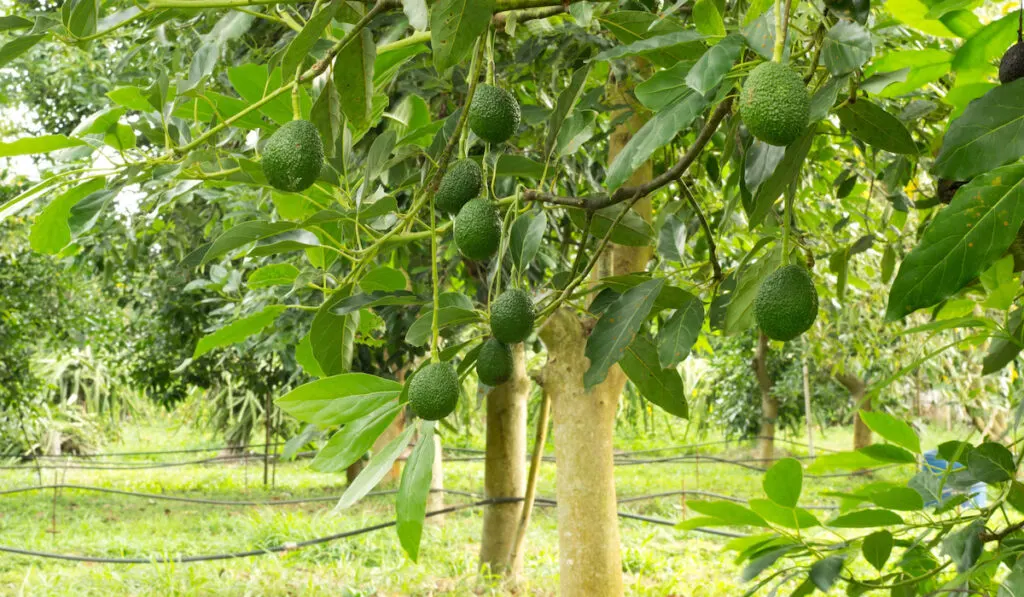
Avocado trees are tropical/subtropical evergreen trees that produce yellow, ivory, or white flowers. You can grow them from the pit or from cuttings. But if you grow them from seeds, they will not grow true.
Besides not growing true, avocado trees grown from seeds take around 10 to 13 years to bear fruits. Conversely, those grown from cuttings take about 5 to 8 years to bear fruits.
Avocado trees enjoy getting a lot of sun in warm temperatures. They do not do well in hot or cold temperatures – they are sensitive to colder temperatures in particular.
Avocado trees can survive in various well-drained soil types, whether acidic or alkaline. They grow best in USDA hardiness zones 8 to 11.
There are over 500 varieties of avocado trees. Interestingly, all of them derive from Mexican, West Indian, and Guatemalan avocados – the 3 main avocado varieties.
The most common avocado varieties are Hass and Fuerte avocado.
Banana Tree
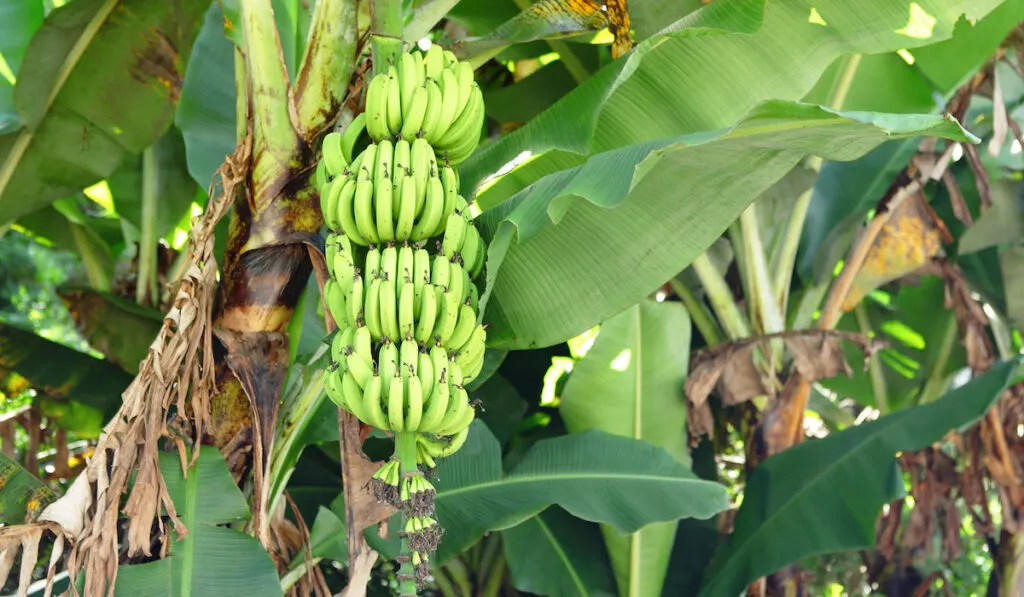
Banana trees are tropical fruit trees that bloom orange, purple, or white flowers. They are native to continents like Africa, Australia, and Asia.
While banana trees are typically referred to as trees, they are not actual trees. Instead, it is more accurate to refer to them as perennial herbs.
Of course, banana trees produce bananas. And while bananas are not what you imagine when you think of berry fruits, bananas are actually berries.
You can cultivate banana trees with rhizomes (such as suckers) or seeds. However, the most common banana tree variety – Cavendish – is typically grown from suckers.
When you grow the tree with a sucker, it takes around 180 days to produce fruits. But with seeds, you’ll have to wait for up to 14 months.
There are over 70 species and more than 1000 varieties of banana trees. The over-1000 banana tree varieties are further divided into 50 groups. Of course, we earlier mentioned that Cavendish is the most common variety.
Banana trees grow best in full sun in hardiness zones 9 to 11. They thrive in well-drained, slightly acidic, loamy soil.
Coconut Tree

The coconut tree is a member of the palm tree family. It is one very productive tree, seeing as it keeps producing fruits for over 60 years, 12-13 times a year.
The coconut tree produces coconuts, and while there might be a nut in coconut, coconuts are not nuts. They are actually fruits, more specifically drupes or stone fruits.
Since we say coconuts are fruits, you may be wondering if coconut trees have seeds. Well, they do. The brown, hairy shell with fibrous white flesh is the seed of a coconut tree.
Coconut trees are typically grown from their seeds. The ideal pit for planting a coconut tree must have enough water within or it may not germinate.
It takes around 5 to 10 years for a coconut tree to become fruitful. But then, the tree may not reach peak production until its 15th to 20th year.
Coconut trees thrive in USDA hardiness zones 10 and 11. They prefer warm temperatures and are sensitive to cold temperatures – even above freezing point.
Coconut trees grow best in full sun while planted in fast-draining, moderately moist soil. They are not really sensitive to soil pH or salinity. So, you do not have to worry about that when planting them.
While there is only one species of coconut tree in the world, there are many varieties. These varieties fall under 3 classes: tall varieties, dwarf varieties, and hybrid varieties.
Date Palm Tree
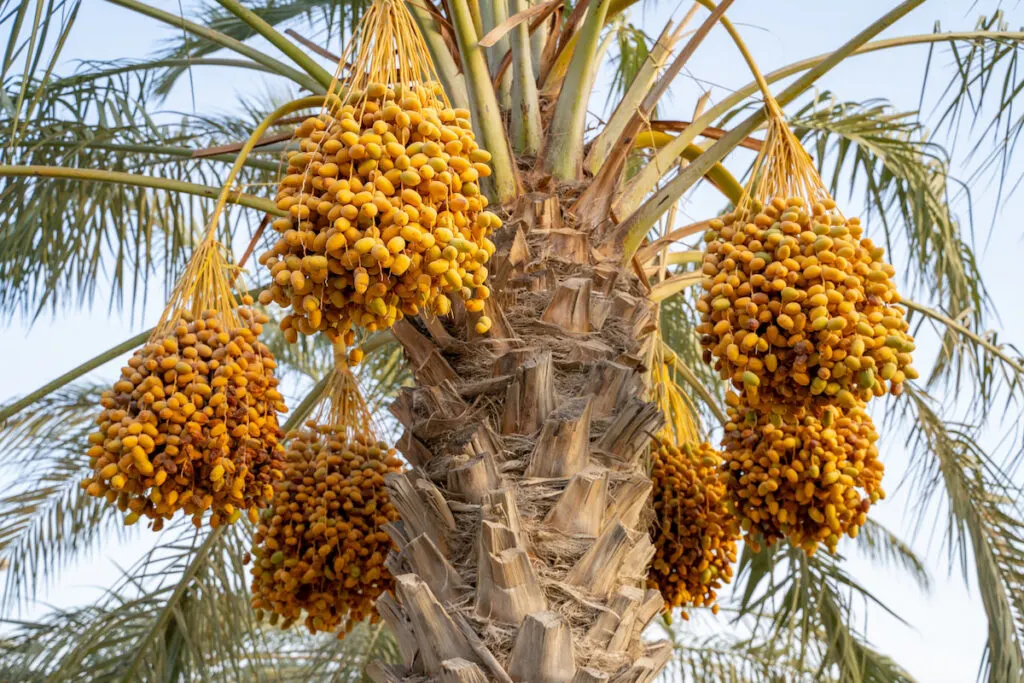
Date palm trees are tropical to subtropical fruit trees that bear sweet, pitted fruits. They are typically cultivated with seeds, and they grow into male or female plants.
Date palm trees are unique in that you need both male and female plants for fruit production. In other words, you need male and female date palm trees to cross-pollinate, so they can bear fruits.
It takes around 4 to 8 years for a date palm tree to bear fruits. But then, peak yield may come 8 to 10 years after planting.
Date palm trees thrive best in full sun and hardiness zones 8 to 11. They prefer warm climates, and you should only plant them in well-draining soil.
There are more than 600 varieties of date palm trees in the world. Each one falls into one of 3 broad categories: soft, dry, and semi-dry.
The most common date palm varieties include Barhi, Medjool, Kadrawi, and Halawi.
Fig Tree
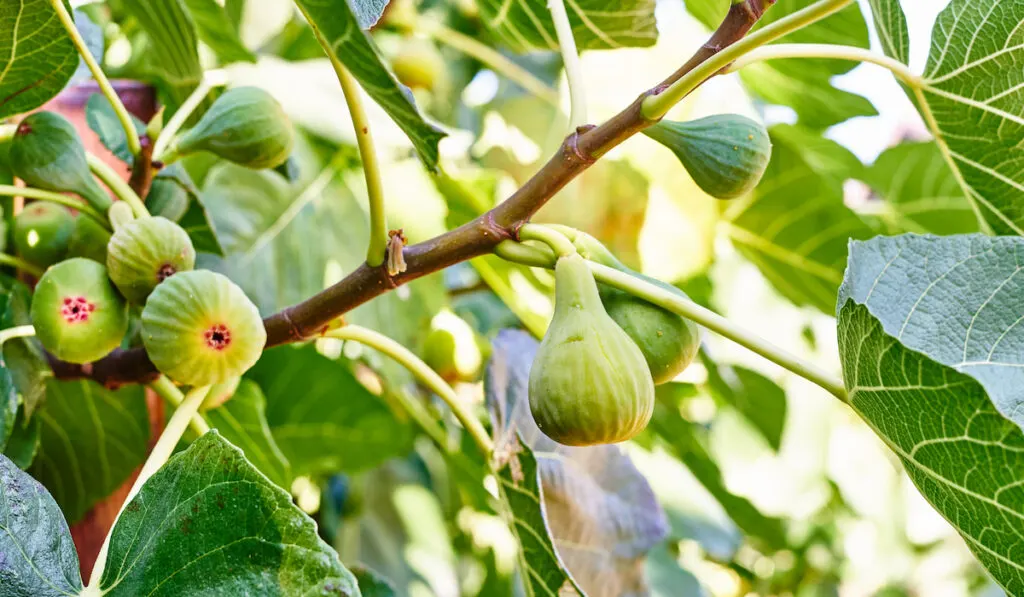
The fig tree is native to warmer climates. However, you will find cultivars that grow just okay in cooler temperatures these days.
You can grow fig trees from cuttings or seeds. However, more times than not, you will find people growing them from cuttings.
In many cases, fig trees do not produce fruits for the first 3 to 5 years. However, it is not uncommon to see them bear small, unripe fruits before then. The said fruits will never get ripe or grow until the tree reaches maturity.
There are over 800 fig species in the world. However, the common fig is the most commonly grown species. The popularity of the common fig is not too surprising since it is one of the few species with edible fruits and no specific pollination requirement.
Fig trees require full sun and well-drained loamy soil for optimal growth. The soil should be fertile and slightly acidic.
Most fig trees grow best in hardiness zones 8 to 10. But some hardy cultivars can survive in zones 6 and 7.
There are over 700 fig tree varieties. Each one falls into one of 4 groups: Smyrna, Common Figs, San Pedro, and Caprifigs.
Guava Tree
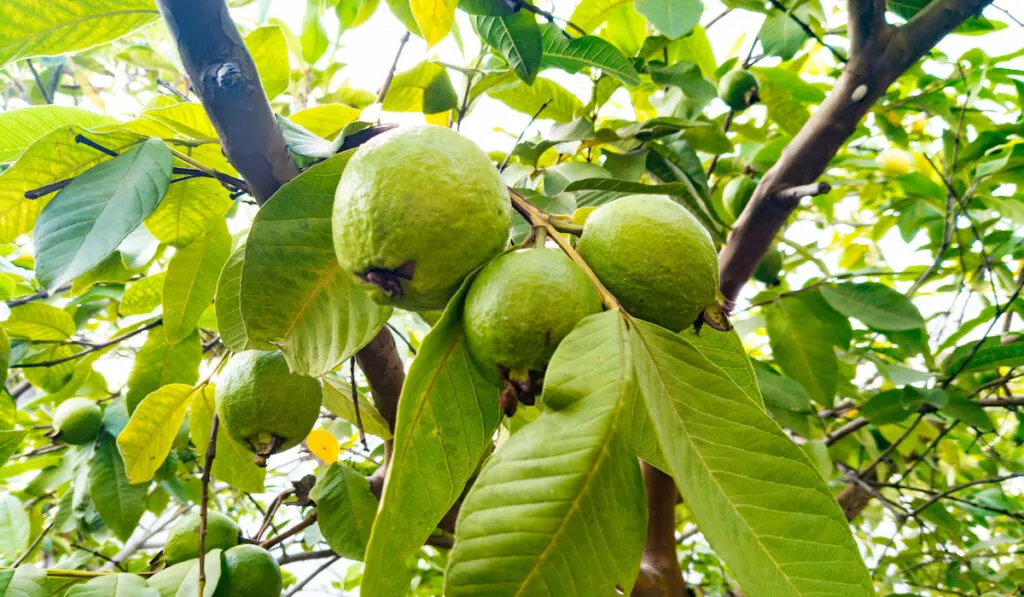
Beyond producing sweet, juicy fruits, guava trees bloom fragrant flowers. You can grow them from their seeds or from cuttings. However, the trees cultivated from seeds do not grow true.
When grown from seeds, it takes around 8 years before the tree starts producing fruits. But with cuttings, it takes about 3 to 4 years.
The guava tree is native to the American tropics. So unsurprisingly, it grows best in full sun. The trees thrive best in well-draining, slightly acidic soil and are best grown in hardiness zones 9 to 12.
While there are as many as 22 varieties/species of guava, the common guava is the most common variety.
Lime Tree

Lime trees are citrus trees from various citrus species, and they are pretty interesting to cultivate. You can grow lime trees from seeds or cuttings. However, most people prefer the latter.
When you grow a lime tree from seeds, it may take around 7 years before it starts producing fruits. But with cuttings or seedlings, it takes 3 to 6 years. Then in the 8th to 10th year, the tree may attain peak production.
For optimal growth, expose lime trees to full sun in a non-windy spot. Plant them in well-draining soil with a lot of organic matter, and protect them from cold and frost. Lime trees grow in hardiness zones 10 and 11.
Many species of the citrus genus produce lime. However, some common ones are Key Lime, Thai Lime, Makrut Lime, Rangpur Lime, Tahiti Lime, and Mexican Lime.
Mango Tree
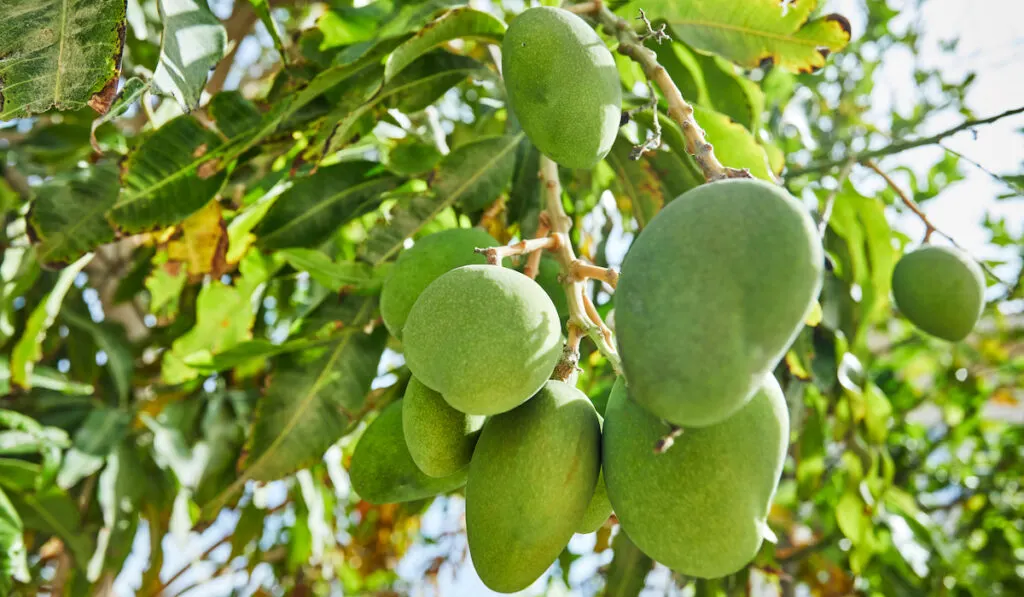
Mango trees are evergreen trees that bloom small-sized, pinkish, and fragrant flowers. You can grow them from seeds, cuttings, or grafted nurseries.
The risk with planting mango trees from seeds is that they sometimes do not grow true. In fact, the pit may germinate into a sterile tree. This is why experts recommend buying grafts instead.
When grown from a seed, it takes a mango tree around 5 to 8 years to produce fruits. But with cuttings, the fruits can come earlier.
Mango trees thrive best when exposed to full sun. Plant them in well-drained loamy soil and protect them from frost. Mango trees thrive in USDA hardiness zones 9 to 11.
There are over 1000 mango cultivars in the world. Amongst them are Cogshall, Carrie, Ice Cream, Ford, Gary, and Pickering.
Papaya Tree

While the palm-like trunk of a papaya tree is not very woody, it is still a tree. Papaya trees are short-lived perennials native to Central America. You will find them across various tropical and subtropical regions of the world.
In most cases, people grow papaya trees from seeds. However, you could also grow them from cuttings. When grown from seeds, papaya plants germinate within 2 weeks, and in around 6 to 11 months, they may start producing fruits.
Papaya trees grow best in full sun and well-drained soil (they may need fertilizer). They thrive in hardiness zones 9 and 10, and you should provide them with some protection from cold and wind.
Mexican and Hawaiian are the two most common varieties of papaya trees. But apart from them, there is Bettina, Kamiya, Hortus, Peterson, Kapoho, and many more.
Resources
- https://www.wonderopolis.org/wonder/does-all-fruit-grow-on-trees
- https://www.pnc.com/en/about-pnc/corporate-responsibility/grow-up-great/lesson-center/farm-to-preschool/where-fruits-grow.html
- https://www.almanac.com/plant/apples
- https://minnetonkaorchards.com/how-long-to-grow-an-apple-tree/
- https://web.extension.illinois.edu/apples/facts.cfm
- https://www.hgtv.com/shopping/news-and-trends/step-aside-red-delicious-the-next-wave-in-apple-picking-pictures
- https://gardenseason.com/growing-apricots-from-seeds/
- https://homeguides.sfgate.com/long-apricots-grow-fruit-74302.html
- https://www.masterclass.com/articles/how-to-grow-an-apricot-tree-in-your-garden#how-to-plant-an-apricot-seed-in-8-steps
- https://homeguides.sfgate.com/apricot-varieties-41395.html
- https://growgreatfruit.com/why-we-love-apricot-trees/
- https://homeguides.sfgate.com/make-avocado-tree-bear-fruit-44718.html
- https://plantinstructions.com/fruit/how-to-propagate-avocado-from-cuttings-grow-your-own-avocado-tree/
- https://www.gardeningknowhow.com/edible/fruits/avocado/avocado-tree-growing.htm
- https://homeguides.sfgate.com/conditions-required-grow-avocado-tree-55767.html
- https://www.homestratosphere.com/types-of-avocados/
- https://www.thespruce.com/do-bananas-have-seeds-3269378
- https://www.thespruce.com/banana-tree-growing-profile-3269353
- https://www.sciencedirect.com/science/article/pii/B9780128012260000074
- https://www.gardeningknowhow.com/edible/fruits/coconut/growing-coconut-palm-trees.htm
- https://homeguides.sfgate.com/long-coconut-tree-coconuts-84353.html
- https://www.homestratosphere.com/types-of-coconuts/
- https://www.masterclass.com/articles/how-to-grow-dates#6-varieties-of-dates
- https://www.hunker.com/13426630/how-long-does-a-fig-tree-take-to-produce-fruit
- https://www.gardeningknowhow.com/edible/fruits/figs/different-types-of-fig-trees.htm
- https://www.almanac.com/plant/figs#
- https://www.gardeningknowhow.com/edible/fruits/guava/guava-tree-fruiting.htm
- https://harvesttotable.com/how-to-grow-guava/
- https://www.progardentips.com/guava-tree-varieties/
- https://homeguides.sfgate.com/long-grow-limes-96291.html
- https://www.epicgardening.com/lime-tree-varieties/
- https://www.britannica.com/plant/mango-plant-and-fruit
- https://www.thespruce.com/grow-mango-seeds-1902625#toc-propagating-mango-trees
- https://www.gardeningknowhow.com/edible/fruits/papaya/growing-papaya-fruit.htm
- https://edis.ifas.ufl.edu/pdf/MG/MG05400.pdf
- https://www.britannica.com/plant/papaya
- https://balconygardenweb.com/different-types-of-papayas-best-tasting-variety/
